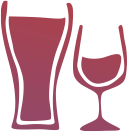Wine isn’t just a drink; it’s an experience. And like any good experience, the details matter. You may have spent hours selecting the perfect bottle, but if you’re drinking a crisp Chardonnay from a heavy goblet or pouring a bold Cabernet Sauvignon into a narrow flute, you’re missing out on the magic that happens when the right wine meets the right glass. Let’s dive into the world of wine glass styles to uncover how they impact your wine and which glass pairs best with each type of wine.
The Anatomy of a Wine Glass: Why Shape Matters
At first glance, wine glasses might seem like elegant vessels with minor variations in shape. However, these shapes have a profound effect on how wine interacts with air, how aromas are captured, and how the wine lands on your palate. Key components to consider:
-
Bowl Size and Shape: The bowl determines how much air interacts with the wine. A larger bowl allows for better aeration, enhancing the wine’s aromas and flavors.
-
Rim Diameter: A wide rim delivers the wine to different parts of your palate, affecting how you perceive its flavor. Narrow rims focus the wine’s bouquet.
-
Stem: The stem prevents your hand’s warmth from affecting the wine’s temperature.
-
Base: Stability is key, but this part doesn’t affect the tasting experience (unless you spill!).
Wine Glass Styles and Their Impact on Wine
1. Bordeaux Glass
- Features: Tall bowl, wide rim.
- Ideal For: Bold red wines like Cabernet Sauvignon, Merlot, and Syrah.
- Why It Works: The tall bowl allows the wine to aerate, taming tannins and enhancing the aromas. The wide rim directs the wine to the back of the mouth, balancing its bold flavors.
2. Burgundy Glass
- Features: A large, round bowl with a narrower opening.
- Ideal For: Delicate reds like Pinot Noir and light whites like Chardonnay.
- Why It Works: The wide bowl enhances the subtler aromas of these wines, while the narrower rim concentrates the bouquet for a fuller aromatic experience.
3. Standard White Wine Glass
- Features: A smaller bowl than red wine glasses, slightly tapered at the rim.
- Ideal For: Light to medium-bodied whites like Sauvignon Blanc and Riesling.
- Why It Works: The smaller bowl keeps the wine cool longer and focuses the delicate aromas to the nose.
4. Champagne Flute
- Features: Tall and narrow with a small opening.
- Ideal For: Sparkling wines and Champagne.
- Why It Works: The narrow shape preserves carbonation and showcases the beautiful bead of bubbles while concentrating the delicate aromas.
5. Coupe Glass
- Features: Wide, shallow bowl.
- Ideal For: Classic cocktails or vintage sparkling wines.
- Why It Works: While visually stunning, it’s not ideal for maintaining carbonation, making it better suited for sipping rather than savoring the sparkle.
6. Universal Wine Glass
- Features: A mid-sized bowl and slightly tapered rim.
- Ideal For: A variety of wines when space is limited.
- Why It Works: While it doesn’t specialize, this glass offers a balanced experience for reds, whites, and rosés alike.
|
$149.99
|
$55.38
|
$150.00
|
N/A
|
$75.95
|
The Science Behind Wine Glass Shapes: Aroma and Aeration
Wine is a symphony of aromas and flavors, and the glass acts as a stage. A glass’s shape influences the surface area of the wine exposed to air, which impacts how it opens up. The rim’s angle determines how aromas are funneled to your nose, a critical aspect of the tasting experience since much of flavor perception is tied to smell.
For example, a Burgundy glass’s large bowl allows delicate Pinot Noir to aerate fully, enhancing its earthy, floral aromas. Conversely, a Champagne flute’s narrow design traps effervescence and directs fruit-forward notes to the nose, maintaining the celebratory vibe.
How to Choose the Right Wine Glass for Any Occasion
If you’re building a collection, start with the essentials:
Bordeaux Glass: Perfect for bold reds.
White Wine Glass: A must-have for crisp whites and versatile enough for rosés.
Champagne Flute: Essential for toasting any occasion.
Universal Glass: Great for casual wine nights with friends or spending the day at the San Diego Food + Wine Festival.
Enhance Your Wine Tasting Experience with the Right Glass
Whether you’re enjoying a sunlit picnic with Sauvignon Blanc or hosting an elegant dinner with a prized bottle of Barolo, the right glass will enhance every sip. At the San Diego Food + Wine Festival, we’ll toast to the art of wine tasting and the joy of sharing unforgettable experiences. Ready to explore more? Check out our curated wine tastings and glassware demonstrations this year—your palate will thank you.
Frequently Asked Questions About Wine Glasses
What is the best wine glass shape for red wines?
The Bordeaux glass and Burgundy glass are ideal for red wines. Bordeaux glasses suit bold reds like Cabernet Sauvignon, while Burgundy glasses highlight the delicate aromas of Pinot Noir.
Does the shape of a wine glass really matter?
Yes! Glass shape affects how wine interacts with air, concentrates aromas, and delivers wine to your palate.
What is a universal wine glass?
A universal wine glass is designed to handle a variety of wines, making it a great all-purpose option for reds, whites, and rosés.
What glass is best for sparkling wine?
Champagne flutes are ideal for sparkling wine as they preserve bubbles and focus aromas.
Use this guide to perfect your wine enjoyment and elevate every pour!







